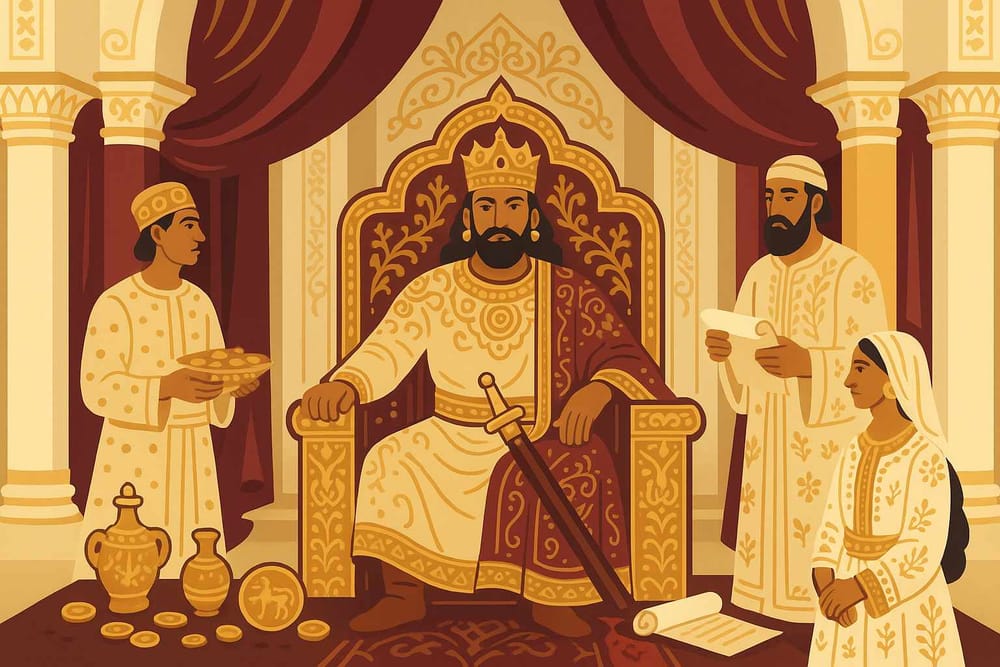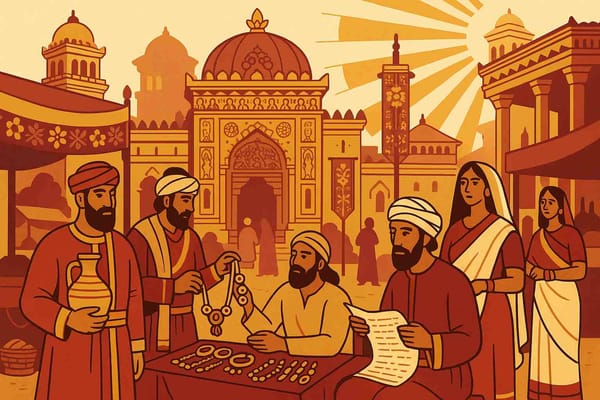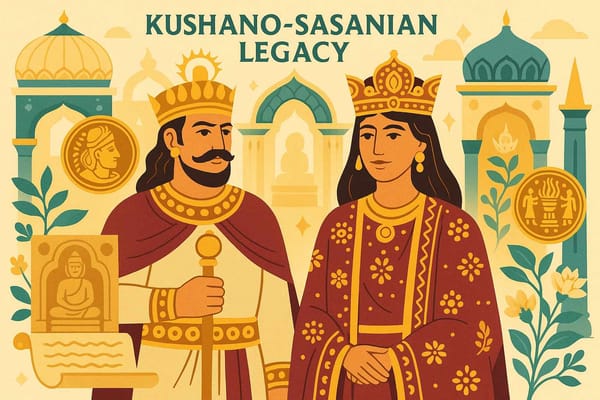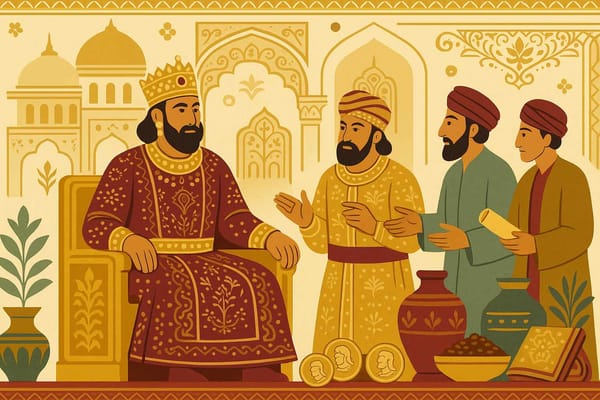
Kushano-Sasanians-Ancient Empires: Origins, Culture, and Legacy
History isn't always about great wars and conquests. Sometimes, it’s about a quiet, beautiful merging of worlds. Imagine a time, around the 3rd century CE, in the lands we now know as Afghanistan, Pakistan, and Northern India. Here, two mighty empires didn't just clash; they embraced. The powerful Sasanian dynasty from Persia extended its hand towards the culturally rich Kushan Empire, and from this handshake, a unique civilisation was born: the Kushano-Sasanians.
This wasn't just a change of rulers; it was a symphony of cultures, a period where art, faith, and trade routes intertwined to create a story that still echoes through the ages. It’s a story of a hybrid empire that became a bridge connecting the great worlds of India, Persia, and Central Asia.
The Dawn of a New Era: How Two Worlds Became One
The story of the Kushano-Sasanians begins at a fascinating turning point in history. The once-mighty Kushan Empire was facing a slow decline, while the Sasanian Empire from Persia, under ambitious rulers like Ardashir I and Shapur I, was expanding eastward. But what happened next wasn't a simple takeover. It was a masterclass in diplomacy and respect for local traditions.
The Sasanian princes who governed these new territories didn't just impose their rule. Instead, they adopted the title "Kushanshah," meaning "King of the Kushans." This simple act was a powerful gesture. It showed that they were there not just to rule, but to continue a legacy, to blend their strength with the existing cultural fabric. Cities like Bactra (modern-day Balkh) didn't just become administrative outposts; they transformed into vibrant hubs where Persian governance met Indian spirituality and Central Asian dynamism.
A Tapestry of Faith and Art
What truly makes the Kushano-Sasanian era magical is the beautiful harmony they fostered between different cultures and beliefs. Their world was a melting pot where ideas were exchanged as freely as goods on the Silk Road.
- A Coinage That Tells a Story: You can learn so much about a kingdom from its coins. The Kushano-Sasanian coins were like miniature history books. On one side, you might see a Sasanian-style king with his majestic crown, but on the other, you could find the revered Hindu figures of Lord Shiva and his vahana, Nandi. This wasn't just currency; it was a statement of unity and respect for the local Hindu faith.
- Where Different Faiths Lived Side-by-Side: In this empire, Zoroastrian fire altars coexisted peacefully with thriving Buddhist monasteries. It was a land of spiritual tolerance. In fact, it's believed that the prophet Mani, the founder of Manichaeism, travelled through these lands and was deeply influenced by the Buddhist culture of Gandhara. This shows a remarkable openness to different spiritual paths.
- Art That Breathed a New Life: The art from this period is a stunning fusion. Sasanian artistic styles blended with existing Kushan and Gandharan art, creating sculptures and designs that were entirely new. This incredible ability to blend artistic traditions is a powerful reminder of how storytelling and art sustain our spiritual heritage, a concept we deeply explore in our piece on preserving legacies through art.
Guardians of the Bustling Silk Road
The Kushano-Sasanians held the keys to one of the most important economic arteries of the ancient world: the Silk Road. Their strategic location made them the gatekeepers of trade between the East and West.
Vibrant cities like Kabul, Herat, and Merv buzzed with activity. Caravans laden with silk from China, spices and gemstones from India, and textiles from Persia passed through their territories. This constant flow of goods did more than just build their economy; it fueled a continuous exchange of ideas, technologies, and stories. The coins they minted, with inscriptions in Bactrian, Brahmi, and Pahlavi, became a trusted currency across this vast network, helping merchants from different lands communicate and trade with ease.
At Bhaktilipi, we are inspired by this spirit of connection. Just as the Kushano-Sasanians created a bridge between cultures, our mission is to connect today's generation with the timeless wisdom of our devotional literature. We are dedicated to preserving, reimagining, and sharing these sacred stories and texts in a way that feels authentic and inspiring. Whether you seek ancient texts in their original form or modern interpretations that speak to your heart, Bhaktilipi is your space to explore. We invite you to join our community and enrich your spiritual journey.
Connect with our world of devotion:
The Sunset of an Empire and its Everlasting Legacy
Like all great empires, the Kushano-Sasanian era eventually came to an end by the 5th century CE, facing pressure from groups like the Kidarites and Hephthalites. But their story didn't fade away. Their true legacy isn't in the size of their kingdom, but in the richness of the culture they nurtured.
They teach us that greatness can come from unity, not just dominance. By blending the administrative genius of the Sasanians with the deep spiritual and artistic heritage of the Kushans, they wove a cultural thread that has enriched our history forever. They remind us that when different traditions meet with respect and openness, they don't just survive; they create something even more beautiful.
Exploring the Kushano-Sasanian World
Many are curious about this unique chapter of our past. The story of the Kushano-Sasanians begins in the 3rd century CE, born from the Sasanian Empire's expansion into the Kushan territories. Their significance in history lies in their incredible role as a cultural and economic bridge. They masterfully connected India, Persia, and Central Asia, creating a vibrant melting pot of traditions.
Their influence on trade was immense. By controlling and securing vital stretches of the Silk Road, they ensured a steady flow of goods, ideas, and beliefs between the great civilisations of the time. Their coins, featuring a unique mix of Kushan and Sasanian designs, were not just currency but a symbol of this powerful fusion. In terms of faith, they fostered an environment of rare tolerance, where Buddhism and Zoroastrianism flourished side-by-side, and elements of Hinduism were respectfully integrated, shaping the spiritual landscape of regions like modern-day Afghanistan and Central Asia for centuries to come.
A passionate group of people dedicated to preserving India's knowledge of Dharma, Karma, and Bhakti for ourselves and the world 🙏.
Comments
Related in

The Kushano-Sasanians- Explore the Empire's Secrets
Sometimes, the most fascinating stories of our motherland are not the ones we learn in school. We talk endlessly about the Mauryas, the Guptas, and the Mughals, but history has countless hidden chapters, tucked away in the sands of time. One such incredible tale is that of the Kushano-Sasanians, an

Exploring the Legacy of the Kushano-Sasanians: History and Impact
History isn't always about grand battles and massive empires that we read in school textbooks. Sometimes, the most beautiful chapters are written in the quiet spaces in between, where cultures meet, shake hands, and create something entirely new. Imagine a time when the powerful Persian Sasanian empire extended

Kushano-Sasanians- A Forgotten Era of History Explained
History, as we often read it, is a grand narrative of mighty empires and legendary conquerors. But sometimes, the most fascinating tales are hidden in the folds, in the chapters that speak not of conquest, but of confluence—a beautiful sangam of cultures. One such forgotten story is that of
